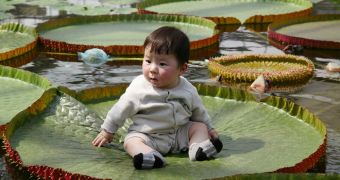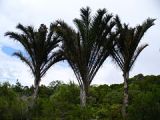Plants living in temperate or cold areas use to shed their leaves annually. That's why records of leaf size won't be found amongst them.
But if you thought the 6 m (20 ft) long leaf of a banana tree is impressive, what about 20 m (66 ft) long leaves?
The largest leaves belong to the raffia palm (Raphia farinifera) and the Amazonian bamboo palm (Raphia taedigera) growing up to 20 meters long! Raffia fibers are used for ropes, sticks, supporting beams and various roof coverings. The fibers are extracted from the long leaves and their stalks.
Some floating leaves can reach impressive sizes, resembling small rafts. Such a plant raft is found on the Amazon River: the Amazon waterlily (Victoria amazonica) has leaves up to 3 m (10 ft) in diameter. The round leaves are vivid green on the upper part and violet on the lower side. The edges of the leaf are raised 5-6 cm (2-2.4 in), hence the name "yrupe" (water dish) given by local Indians. The submerged stalks of the leaves are 7-8 m (23-26 ft) long.
Birds use these leaves as bathing places, and the giant leaves can support up to 90 kg (200 pounds) of sand, if uniformly distributed on its surface. Still, a child up to 30 kg (66 pounds) can float safely on this leaf... The large ribs on the lower part of the leaf accumulate air, explaining this flotation.
You may enjoy tequila, but do you know what is it made from? Some huge leaves...
Agave plants living in the dry areas in Mexico have 1-2 m (3.3-6.6 ft) long leaves that can weigh up to 10-20 kg (22-44 pounds). That's because the leaves accumulate a sugary liquid, a reserve of the plant preparing to blossom. This sap is collected; an agave can produce it for 6 months, after which the plants dies. The resulting fermented alcoholic drink is called tequila, mezcal, puelche or Maguey wine, depending on the processing and type of Agave.

 14 DAY TRIAL //
14 DAY TRIAL // 
